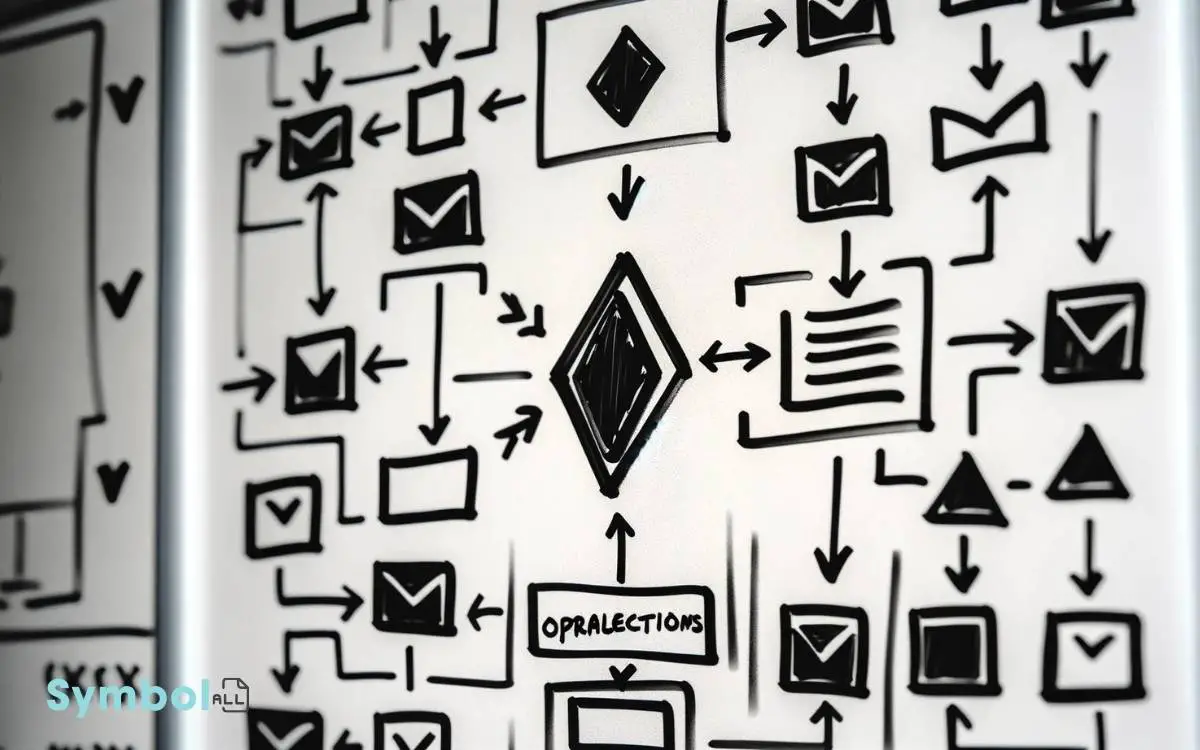Which Flowcharting Symbol Is Used for Opening and Closing Files?
In flowcharting, the symbol used for opening and closing files is specific and designed to convey these actions unmistakably. This symbol is critical for delineating data management sequences accurately.
You’ll find it distinct from others, often depicted in shades of blue or grey, which aids in quick recognition and minimizes errors. Proper utilization ensures clarity and streamlines the communication of processes, particularly where file operations are integral.
Proper positioning before data processing symbols is key to indicating the sequence of file interactions. Grasping the nuances of this symbol enhances your flowchart’s precision. As you further explore, you’ll unlock deeper insights into effective diagramming.

Key Takeaways
The Importance of Symbols
In flowcharting, symbols serve as the backbone of visual communication, efficiently translating complex processes into easily understandable diagrams.
You’ll discover that each symbol has a distinct shape and purpose, designed to streamline the conveyance of information and minimize ambiguity.
This meticulous selection of symbols facilitates a universally comprehensible language, enabling you to quickly grasp the essence of a process without necessitating exhaustive explanations.
Particularly, when it comes to opening and closing files, the choice of symbol is pivotal. It not only denotes the action but also integrates seamlessly into the broader flow, ensuring a cohesive read.
Flowcharting Basics
Delving into flowcharting basics, you’ll first need to understand that each symbol acts as a critical node within the diagram, precisely defining a specific action or decision point.
Flowcharts are invaluable in visualizing and analyzing processes, particularly in fields like software development and system design.
To master flowcharting:
- Understand the purpose: Recognize the goal of your flowchart. Is it for process documentation, problem-solving, or process improvement?
- Learn symbol meanings: Each shape conveys a distinct action or process.
- Follow flowchart rules: Ensure coherence in direction and structure for readability.
- Use connectors wisely: These manage flow in complex diagrams.
- Practice consistency: Stick to standard symbols and conventions to avoid confusion.
Grasping these fundamentals sets a solid foundation for proficient flowcharting, paving the way for more advanced topics, such as specific symbols for file operations.
Symbols for File Operations
Building on your understanding of flowcharting basics, let’s explore the symbols specific to file operations. In flowcharting, each symbol is meticulously designed to represent different actions or steps in a process.
When it comes to file operations, such as opening, reading, writing, or closing files, specific symbols are employed to denote these actions. These symbols are critical for accurately depicting the flow of data and operations within a system.
Understanding these symbols allows you to create precise and analytically sound flowcharts. It’s essential to recognize that the choice of symbol directly impacts the clarity and efficiency of the final flowchart.
Identifying the Correct Icon
You must accurately identify the appropriate icon for opening and closing files to ensure efficient flowcharting. This entails understanding each symbol’s explanation and analyzing practical usage examples.
Recognizing these icons streamlines the process, reducing errors and enhancing readability in documentation.
Symbol Explanation
Identifying the correct icon for opening and closing files in flowcharts requires understanding their unique shapes and colors.
Specifically, the symbol used is often a rectangle with a wave-like bottom, symbolizing a document or file. This icon’s design is critical for ensuring clarity in flowchart diagrams.
- Unique Shape: The wavy bottom line distinguishes it from other rectangles.
- Standard Color: Often depicted in blue or grey, indicating an action related to document handling.
- Size Consistency: Maintains proportion with other symbols for uniformity.
- Labeling: Contains a brief, descriptive label, such as ‘Open File’ or ‘Close File’.
- Positioning: Strategically placed to indicate the sequence of operations.
This technical precision aids in visualizing the process flow, enhancing understanding for users familiar with flowchart conventions.
Practical Usage Examples
To effectively discern the correct icon for opening and closing files in flowcharts, let’s explore practical usage examples that highlight the distinctive characteristics and applications of this symbol.
Imagine you’re designing a process to automate document handling. You’d employ the designated symbol at the start to indicate opening a file for data extraction. This action initiates the workflow, ensuring clarity in operation commencement.
Subsequently, towards the end, the same symbol signifies the closure of the file, marking the process completion. This dual-use promotes a streamlined, unambiguous interpretation of the workflow’s start and end points.
Precisely, it’s pivotal in delineating resource management within the flowchart, showcasing its necessity for accurate, efficient procedural documentation. Understanding its correct application ensures your flowcharts are both technically sound and easily interpretable.
The Design of the Symbol
You must understand that the symbol’s shape carries specific meanings essential for effective communication in flowcharts.
Additionally, the application of color coding significantly enhances the symbol’s visibility and interpretability.
Analyzing these aspects ensures that users can accurately identify the actions of opening and closing files within the flowchart.
Symbol Shape Meaning
In flowcharting, the design of a symbol specifically conveys its function, with the symbol for opening and closing files distinguished by its unique shape.
This specific shape isn’t arbitrarily chosen but is meticulously designed to represent its operational purpose within a processing sequence.
Here’s why understanding the shape meaning is crucial:
- It facilitates rapid identification within a complex diagram.
- The shape’s design minimizes ambiguity, enhancing process clarity.
- It supports universal comprehension across diverse technical backgrounds.
- Different shapes often imply different types of file operations.
- Recognizing the shape allows for quicker troubleshooting and analysis.
Each symbol in a flowchart is a visual cue, with its geometry serving as a direct link to its function. This precision ensures that flowcharts remain an indispensable tool in system design and analysis, communicating complex processes through standardized visual elements.
Color Coding Importance
Beyond shape, color coding plays a pivotal role in enhancing the functionality and readability of flowchart symbols.
You’ll find that color not only differentiates between various actions and processes but also serves as a quick visual cue, streamlining your comprehension and analysis of complex procedures.
For instance, symbols related to file operations, like opening and closing files, might adopt a distinct hue to immediately signal their function, reducing the cognitive load on you as you navigate through the flowchart.
This strategic use of color aids in minimizing misinterpretation and accelerates the decision-making process.
It’s essential, therefore, to understand the color scheme employed in a flowchart to fully grasp the nuances of its design and intent.
Significance in Flowcharting
Understanding the flowchart symbol for opening and closing files is crucial for accurately mapping out the sequence of operations in a process.
This symbol plays a pivotal role for several reasons:
- It specifies the start and end points for file interactions, ensuring clarity in process mapping.
- It helps in identifying potential bottlenecks related to file access.
- It facilitates the debugging process by pinpointing exactly where files are opened and closed.
- It aids in optimizing the flow of operations by revealing unnecessary file accesses.
- It ensures compliance with data handling and security protocols by clearly marking file interactions.
Grasping the importance of this symbol allows you to design more efficient, secure, and effective processes.
Using the Symbol Correctly
To ensure process efficiency, it’s critical you deploy the symbol for opening and closing files accurately within your flowcharts.
This symbol, often a rectangle with a wave-like bottom, signifies a crucial step in data management processes, indicating the start or end of file interaction.
Proper placement is essential: position this symbol immediately before data processing activities to denote file opening, and directly after to indicate file closing. This strategic placement ensures clarity in the sequence of operations, facilitating a smooth workflow.
Additionally, it’s imperative to label the symbol explicitly with the file operation (e.g., ‘Open Customer Database’ or ‘Close Transaction Log’) to avoid ambiguity.
Precise use and clear labeling of this symbol enhance readability, making your flowchart an effective tool for process analysis and optimization.
Common Mistakes to Avoid
When creating flowcharts, it’s crucial to avoid common mistakes that can compromise the clarity and effectiveness of your diagrams. These errors often stem from overlooking fundamental principles or misunderstanding the purposes of specific symbols.
To ensure your flowcharts are clear and effective, avoid these common pitfalls:
- Misusing symbols, particularly the one for opening and closing files.
- Overcomplicating the flow with unnecessary steps or details.
- Neglecting to label symbols or using unclear labels.
- Failing to maintain a consistent level of detail throughout the diagram.
- Ignoring the standard flow direction, which typically goes from top to bottom and left to right.
Each mistake can significantly impede the reader’s ability to understand the process being diagrammed, undermining the flowchart’s intended purpose.
Tips for Effective Diagramming
To enhance your flowchart’s readability, you must select the appropriate symbols that accurately represent file operations. Simplifying complex processes into manageable components improves the diagram’s comprehensibility.
Additionally, implementing color coding can significantly aid in differentiating between various file actions, streamlining the interpretation process.
Choosing Right Symbols
Selecting the appropriate symbols can significantly streamline your diagramming process, ensuring clarity and efficiency. It’s pivotal to choose symbols that distinctly encapsulate the function they represent.
Here’s a quick guide to ensure you’re on the right path:
- Identify your diagram’s purpose to select symbols that align with its objectives.
- Familiarize yourself with standard symbols to maintain consistency and readability.
- Use decision symbols to clearly depict branching paths.
- Employ process symbols for actions or steps in a sequence.
- Incorporate data symbols for inputs and outputs, enhancing the diagram’s informativeness.
Simplifying Complex Processes
Simplifying complex processes requires breaking them down into smaller, manageable steps, ensuring your diagram is both efficient and comprehensible.
When you’re developing a flowchart, each element should represent a distinct action or decision point, making the overall process easier to follow.
Here’s a quick guide to streamline your diagramming efforts:
| Step | Action |
|---|---|
| 1 | Identify the main process. |
| 2 | Break down into sub-processes. |
| 3 | Define clear start and end points. |
| 4 | Use standard symbols consistently. |
| 5 | Eliminate unnecessary steps. |
Utilizing Color Coding
After mastering the basics of flowchart symbols and streamlining processes, it’s important to consider how color coding can enhance your diagram’s clarity and readability.
Utilizing color effectively allows you to:
- Highlight critical paths, making them immediately identifiable.
- Differentiate between types of operations, such as input/output vs. processing tasks.
- Indicate the status of a process, like completed, in-progress, or pending.
- Organize information hierarchically, providing visual cues to understand the flowchart’s structure.
- Enhance user engagement, as visually appealing diagrams are more likely to be comprehended and retained.
Advanced Flowcharting Techniques
Delving into advanced flowcharting techniques, you’ll encounter a range of symbols and methodologies that enhance the precision and clarity of your diagrams.
Among these, conditional or decision symbols enable you to represent decision points with acute accuracy, facilitating the depiction of complex logic paths.
Looping and iteration symbols are crucial for illustrating repetitive processes, allowing you to efficiently communicate procedures that require recurrence until a specific condition is met.
Furthermore, parallel process symbols help in showcasing tasks that can occur simultaneously, highlighting efficiency and concurrency in operations.
Mastering these techniques not only elevates your flowcharting skills but also empowers you to convey intricate processes in a digestible format, ensuring your audience grasps the full scope of the workflow without ambiguity.
Enhancing Communication With Symbols
Incorporating specific symbols into your flowcharts can significantly enhance the clarity and efficiency of communication, allowing you to convey complex processes with greater precision.
Symbols serve as the building blocks of flowcharts, each representing a unique action or step in the process.
By harnessing these visual tools, you’re able to:
- Streamline the understanding of operational sequences
- Facilitate quicker decision-making processes
- Minimize misinterpretations by standardizing symbol meanings
- Enhance the readability of complex workflows
- Foster a universal language across diverse teams
Employing these symbols strategically within your flowcharts not only augments the flow of information but also empowers team members to grasp intricate processes swiftly.
This methodical approach ensures that every participant comprehends the intended message, fostering an environment of clear and efficient communication.
Conclusion
In the vast landscape of flowcharting, picture yourself as a skilled cartographer, mapping the digital terrain.
The symbol for opening and closing files is your compass, guiding data’s journey through code’s wilderness.
It’s crucial, like finding water in a desert, to avoid the mirages of common errors.
Employ this icon wisely, as a master craftsman uses a tool, ensuring your diagram’s message is as clear and precise as a star in the night sky.
Navigate with confidence, for this symbol is your beacon in the complex world of flowcharting.




